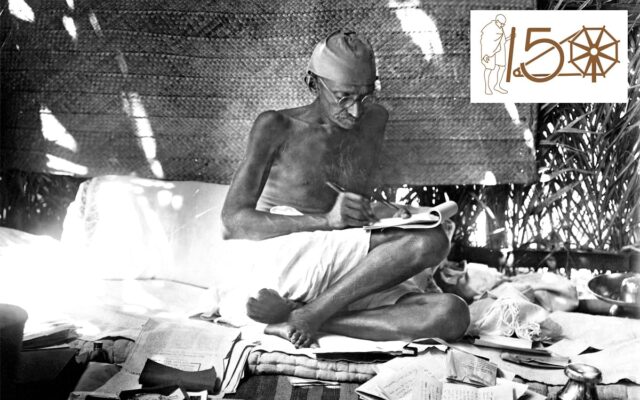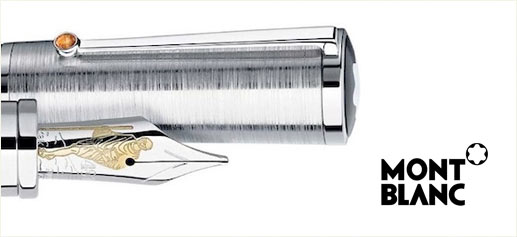As Edward Bulwer-Lytton said, “The pen is mightier than the sword”. Thus to celebrate what is perhaps the most powerful weapon one can have, Fountain Pen Day was observed all across the world on the first Friday of November, which was yesterday.
In fact, India herself has a long journey of make and unmake and a golden history, inked by these pens. However, as we commemorate this glory, we must know that this pen was initially not very welcome in India. But why was it so? Let’s know!
The ‘Gandhi’ Pen Controversy
Not long ago there was an intense controversy over Montblanc’s limited-edition ‘Gandhi’ pen. The Swiss luxury giant which used Mahatma Gandhi’s name and image in its product, linking a 14 lakh rupees luxury pen to an epitome of simplicity, welcomed wrath.
Two days after Mahatma Gandhi’s great-grandson, Tushar Gandhi, launched the ‘Gandhi’ pen, the Kerala High Court issued notices to Montblanc and the Union Ministry of Consumer Affairs while admitting public interest litigation that challenged luxury pen markets in India.
Dijo Kapen, the petitioner from the Centre of Consumer Education in Kottayam, argued that it was improper, unlawful, and potentially criminal to attempt to produce and distribute luxury pens worth lakhs of rupees using the name of the Mahatma, who stood for the poor and fought against poverty throughout his entire life.
He further argued that, entry 9A of the schedule of the Emblems and Names (Prevention of Improper Use) Act, 1950, prohibits the use of Mahatma Gandhi’s name or any pictorial representations of him as a symbol for carrying out any trade or enterprise.

Kapen argued that making Gandhi the symbol of a Rs 14 lakh pen was nothing more than a crude attempt to humiliate the middle class and people living in poverty who look up to him, as well as to cause degradation of everything he stood for.
Tushar Gandhi, on the other hand, has claimed that the Mahatma’s image has long been used in advertising and has expressed surprise at individuals who are opposed to the project.
Tushar responded to the debate surrounding the Montblanc pen by telling PTI, “I am surprised that they (the people who are opposing it) have woken up so late. Gandhi’s image has been used in advertising for a long time.”
Why were there no controversies sparked when the Aditya Birla Group began selling Eternal Gandhi products, which included fountain pens? The answer, however, is quite simple: Eternal Gandhi fountain pens aren’t insanely expensive.
Also Read: Why Is Modi’s Mission Karmayogi Sending IAS & Defence Officers for Pursuing Courses Under Art of Living, Sadhguru And TISS?
The most ironic thing about the entire affair, however, is neither about using Gandhi’s image for trade nor is it the linkage of luxury with the Mahatma but the fact that Mahatma Gandhi specifically opposed the usage of fountain pens throughout his life.
Fountain Pens: Gandhi’s Disapproval
Gandhi expressed his disapproval of fountain pens, time and again in several of his letters. He rather preferred reed pens that were used prior to the invention of fountain pens.
By “reed pens” he didn’t mean the traditional reed pen constructed of reeds; instead, he meant what is typically referred to as a dip pen. Each of these letters highlighted specific reasons why he thought that fountain pens must be avoided.

Unsuitable For Indian Scripts
In a letter to Parasram Mehrotra dated 20th March 1932, he wrote, ‘There is not the slightest need for the girls to use a fountain pen. Really speaking, nobody in the Ashram should need a fountain pen.
Why should anybody be in such a hurry? For students, at any rate, it is certainly a harmful thing to use. The reed pen is the best for writing Gujarati, Hindi, Urdu and other Indian scripts.’
Promotes A Lavish And Dependent Upbringing
As an “Advice to Students,” he wrote on 28th April 1947,
“For example,
(1) when you get up in the morning you can roll up your own bedding;
(2) help in preparing your breakfast and milk, etc., whatever you take, without waiting for your mother or anyone else to prepare it and serve you;
(3) give a helping hand in sweeping and scrubbing;
(4) do your own laundering;
(5) help your mother with the cooking and cleaning the dishes;
(6) make your own cloth by spinning regularly every day;
(7) keep your books clean and neatly arranged, economize on exercise books as much as possible;
(8) learn to do with a pen-holder and ink costing two annas, instead of a fountain-pen costing Rs. 50.82.”
Costly Yet Affects Handwriting
Gandhi, in a letter he wrote to a child on 14th July 1947 said, “You should give up your fondness for writing with a pencil or fountain-pen. Anybody who wishes to improve his handwriting should use a reed-pen. How can all the children in the country afford to use fountain-pens?
I suppose you know how much a fountain-pen costs. If I was a teacher and had my way, I would forbid the bringing of a fountain-pen into the classroom. But mine has become a lone voice now. If you have any influence with your friends, popularize the use of the reed-pen among them.”
Threat To The Village Economy
In an article on village industries, written in November 1934 he argued, “In a nutshell, of the things we use, we should restrict our purchases to the articles which villages manufacture.
Their manufacturers may be crude. We must try to induce them to improve their workmanship, and not dismiss them because foreign articles or even articles produced in cities, that is, big factories, are superior […]
If this is the correct attitude, then, naturally, we begin with ourselves and thus use, say, handmade paper instead of mill-made, use village reed, wherever possible, instead of the fountain pen or the penholder, ink made in the villages instead of the big factories, etc.
I can multiply instances of this nature. There is hardly anything of daily use in the home which the villagers have not made before and cannot make even now.”
Against The Swadeshi Movement
However, the promotion of the reed pen over the fountain pen wasn’t solely focused on the independent village economy. The concept also had a Swadeshi flavour to it. Fountain pens and reed pens both need ink.
On 15 December 1932, Gandhi wrote to Jamnalal Bajaj, ‘Shri Kateli knew that we had a stock of the Swadeshi ink for the fountain pen which you wanted, and, therefore, we have sent a bottle of it for you. We have quite a large quantity of it.’
It was not until 1932 that Ratnam Pen Works made the first Indian fountain pen, handing over a complete swadeshi version of it to Gandhiji in 1935.

It’s only since then that the fountain pen has become the symbol of the swadeshi movement.
In today’s fast-moving world, the pen (or any other writing instrument) is more of an FMCG product than a symbol of intellect. Fountain pens which were once an important element of literacy enjoying popularity among scholars have been replaced by mass-produced ball and gel pens.
Especially when technology has rendered the art of writing by hand redundant, it is more of an ornament. The fountain pen remains nothing but an element of nostalgia, the love of the antiquarian.
Disclaimer: This article has been fact-checked
Sources: Scroll, The Week, The Print, Livemint +more
Image Source: Google Images
Find the blogger @ParomaDey
This post is tagged under Mahatma Gandhi, Gandhiji, Father of the Nation, Indian Freedom Struggle, swadeshi movement, boycott movement, Tushar Gandhi, Montblanc, Gandhi pen, Swadeshi pen, Fountain Pen Day
Feature image designed by Saudamini Seth
We do not hold any right, copyright over any of the images used, these have been taken from Google. In case of credits or removal, the owner may kindly mail us.
Read More:
Back in Time To 1948: The Father Of The Nation Assassinated By A Right-Wing Nationalist
































